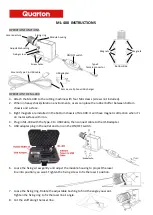
LH-20S USER MANUAL
5
are not difficult to predict. The resulting resistance of polyurethane insulation for two sections
joined together will be equal to:
Rz
M
M
MH
R R
R
R
=
=
=
→
=
⋅
+
⋅
+
1
2
1
2
50 50
50 50
25
13
[
]
Ω
Ω
and after joining section 3:
Rc
M
M
MH
Rz R
Rz R
=
=
≈
→
=
⋅
+
⋅
+
3
3
25 50
25 50
16 8
12
[
]
,
Ω
Ω
Person assembling the pipeline is not misled by the results, and does not try to correct the
joints between the three sections. If the same person performed the installation works, they
will regret not having performed enough control measurements of polyurethane insulation
resistance, as a result of which they allowed moisture to be locked in the joint(s) of the
installed sections.
CASE 2. The person assembling the pipeline measures only the MH moisture level of
polyurethane insulation.
Measurements for sections 1 and 2 of the pipeline suggest very good condition of the alarm
system (MH=0). After the two sections are joined together, however, their resulting MH
moisture level equals 13. Still, the situation is not yet critical. The situation becomes critical
after joining section 3, as a result of which the MH value drops to 12.
Three supposedly correct sections (MH=0) of the alarm system, after they are joined together,
barely meet the technical specifications regarding moisture levels (MH
≥
12).
An inexperienced person will be misled by the results and will look for faults in the joints
between the three sections.
3.2.
Secondary Measurements when MH
≤
11 and when the ZWARCIE
(SHORT CIRCUIT) or C Messages are displayed
Example measurement results are given below:
MH=9 0,8M
Ω
Zwarcie C =7 0,2M
Ω
1000m 5736
Ω
1000m 5736
Ω
1000m 5736
Ω
Each of the problems discussed in this section needs to be located and removed. Choice of
action depends on the condition of the insulation of the copper alarm wire. If, as intended, the
copper wire is not connected electrically to the carrier pipe, either directly (short circuit) or by
the moisture between them, then the wire fault can be located using typical methods and
devices (e.g. the LP-10S fault locator). The condition of copper wire insulation can be tested
by performing a secondary measurement with the LH-20S device. Fig. 3 presents the
connection diagram for the secondary measurement. Note that the alarm loop should be open
at both ends of the tested pipeline section, and the blue wire of the LH-20S detector is not
involved in the measurement.
D
E
T
E
C
T
O
R






























